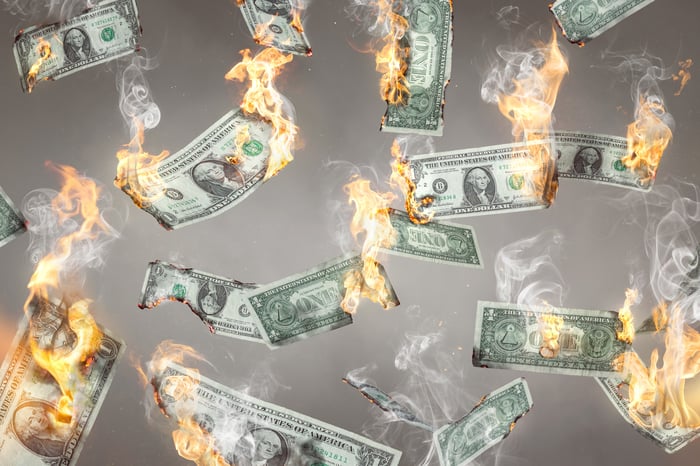There are major crosscurrents impacting Virgin Galactic (SPCE 3.15%) today. On the one hand, the company has finally begun operating its space tourism business. On the other, its business model is actually dependent on a second-generation spaceship that is still in the early stages of development. The best way to see the financial mismatch this will cause is by comparing Virgin Galactic's financial statements to its financial projections.
Listen to what management is telling you
When Virgin Galactic reported second-quarter 2023 earnings, it posted revenue of nearly $1.9 million. That was a jump from the $357,000 it brought in during the same quarter of 2022. This is because the company has now commenced regular flights sending tourists (and scientists) into space. It is, without a doubt, a pivotal moment in the company's history.

Image source: Getty Images.
But according to the company's comments, the long-term business model isn't based around the current version of the spacecraft it is using. A second-generation spacecraft is in the early stages of development, and that is what management believes will lead to a sustainably profitable operation. This isn't exactly a ringing endorsement of the current business, noting that the facilities to build the next class of ship aren't expected to be operating until 2024, with spacecraft testing set for 2025, and a first commercial flight not anticipated until 2026.
And this is where the warning bells should start to go off for investors. It costs a lot of money to build a spacecraft manufacturing facility and, subsequent to that, spaceships. In the second quarter, Virgin lost $134 million and had negative free cash flow of $135 million. Sure, a big increase in revenue might look good, but there is still way more money going out the door than coming in. That's not sustainable over the long term.
More pain ahead for investors
Don't cover your ears by focusing all of your attention on management's story about what it believes to be a huge potential for the business. The opportunity is still years away and most likely, so are sustainable profits. In the meantime, the company will continue to burn cash as it builds its second-generation rocket. In fact, for the second half of 2023, management expects to have negative cash flow of as much as $260 million.
That compares to roughly $980 million of cash and investments on the company's balance sheet. Doing some back-of-the-envelope math, at the projected burn rate Virgin Galactic is a bit shy of two years' worth of cash. It isn't going to make it until 2026 without raising more capital.
And that's exactly what the company did in the second quarter, issuing 55 million shares of common stock to raise $241 million for the business. That buys management time to get the next-generation rocket built, but each one of those shares dilutes current shareholders. This wasn't a one-time event; in the first quarter of 2023 Virgin Galactic issued 5.8 million shares to raise $32 million in cash. Given the cash needs of the business, investors should expect to see even more stock sales in the future.
This isn't unusual: Many companies spend heavily to build out a business before they reach sustainable profits. But that doesn't make Virgin Galactic any less risky. The huge cash needs and lack of profits are two of the most important factors in the stock's massive 50% slide over the past year. And the story is as clear as day if you look at the financial statements and compare them to management's comments.
Don't get sucked in by the hype
A company's management team is destined to sound like a cheer squad, trying to get employees and investors excited about the future. That's doubly true for a company that is, effectively, still just a start up. But there are clear warning bells at Virgin Galactic that investors need to listen to. Maybe the company manages to pull off the long-term plan and it creates a sustainable business by 2026. But the risks seem like they outweigh the rewards right now as the company loses money, burns cash, and sells stock (despite a massive share price decline) to help fund its huge capital investment plans.





